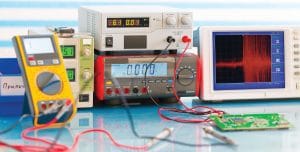
With the increasing complexity of electronic gadgets, testing has become imperative at every stage of the product’s life cycle. Here are some of the key market trends in the electronic test and measurement equipment industry.
By Research Team, ComConnect Consulting
Test and measurement (T&M) systems play a critical role in ratifying the performance of a wide range of electronic products. They are used across the entire product life cycle, starting from the product design and development phase, to production testing, pre- and post-market testing, as well as support. Thus, the growth of the test and measurement industry goes hand in hand with the growth of the electronics industry in the country.
Market opportunities
A big business opportunity is brewing for the test and measurement (T&M) industry in India. This is due to a number of reasons like technology developments, expanding end-user applications and the growing need to validate the performance of equipment. Other factors driving growth in the T&M domain are the stringent quality, safety, and environmental standards for manufacturing, maintenance and the use of equipment. Moreover, proper implementation of government initiatives like Make in India, 100 Smart Cities, Digital India and the defence manufacturing push, will definitely open up new opportunities for T&M industry players.
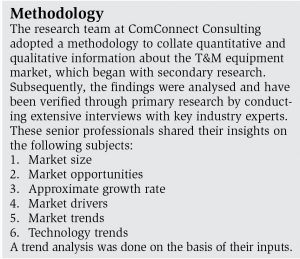 According to some industry experts, the current market size for general-purpose T&M equipment alone is worth over US$ 200 million. However, the market presents a much bigger opportunity considering that Global Industry Analysts Inc. (GIA), a California based market research firm, forecasts that the world market for general-purpose electronic T&M instruments will touch US$ 6.8 billion by 2020.
According to some industry experts, the current market size for general-purpose T&M equipment alone is worth over US$ 200 million. However, the market presents a much bigger opportunity considering that Global Industry Analysts Inc. (GIA), a California based market research firm, forecasts that the world market for general-purpose electronic T&M instruments will touch US$ 6.8 billion by 2020.
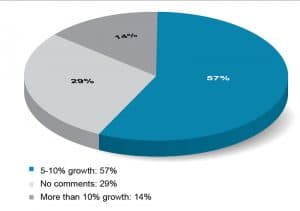
The Indian T&M market is driven by both global and domestic demand. Growth in this market is a result of the growth registered by the key end-user segments like power, automotive, electronics and telecommunications hardware. Defence and other government sectors have also been instrumental in driving the growth of this sector. Besides, the increase in R&D activities across academic organisations is expected to further drive up demand. Our experts forecast steady growth of the T&M sector in India, and approximately 57 per cent of them expect the sector to grow between 5-10 per cent on a year-on-year basis (Figure 1).
Market drivers
In this age of rapidly evolving technology, the T&M domain has continuously leveraged as well as contributed to cutting-edge technology. The T&M sector in India is primarily driven by end-user markets including defence, telecom, broadcasting, consumer electronics, automation and the automotive industry.
Considering the strong government push to make in India in the strategic electronics sector, 70 per cent of the experts mentioned the bright future of the defence manufacturing ecosystem in India and the related opportunities for the T&M segment.
India has vast potential in telecommunications and mobile manufacturing too. With the ‘Make in India’ initiative creating a wave of optimism and opportunities, mobile manufacturing is all set to gain further momentum. Sixty per cent of the experts are looking forward to the burgeoning opportunities in mobile handset manufacturing and allied verticals like mobile services, cable TV, broadcasting, etc.
The various government initiatives, like the Make in India campaign and the development of smart cities, are likely to boost the power and communications sectors in India and eventually contribute to the growth of the T&M industry.
The demand for electricity across India has been growing at a rapid rate and is expected to grow further in the years to come. With the growing demand, power generation, transmission and distribution companies will have to invest in reliable, accurate and efficient equipment to protect their assets from failure. Therefore, the growth prospects of T&M equipment related to the power sector are quite promising. India is an emerging solar hub of the world, considering the kind of capacities that are coming up, with nearly 100GW of solar power to be added in the next five years. Solar power, again, is a very important market for T&M products.
The trend of automotive companies switching to automated testing is also driving up demand for T&M equipment. Moreover, the increasing electronic content in the vehicles for infotainment, connectivity and safety purposes, along with the growing acceptance of green mobility (through e-vehicles) will also fuel the growth of the T&M sector.
According to industry experts, the T&M market in India seems to be booming with the entry of low cost Chinese equipment, even though the quality of such imports is questionable.
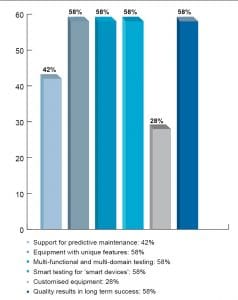
Market trends
While interacting with the experts, our analysis suggested that, going forward, the T&M market will be driven by some special trends (Figure 2), which we have listed below.
Support for predictive maintenance: Increasing awareness about predictive maintenance amongst manufacturers in India is also driving the growth of the T&M industry.
Equipment with unique features: The demand from customers to address complex process issues is forcing T&M companies to innovate continuously. This has resulted in the development of high-end devices with unique features.
Multi-functional and multi-domain testing: Multi-functional testing kits are the latest trend among decision makers of maintenance departments, where instead of having many different testing kits for individual applications, engineers have realised the benefits of using one kit with multi-functional testing capabilities. Such tools save time, money and most importantly, the effort that goes into the testing procedures. New instruments have better GUIs, and provide ease of operation and automated testing capabilities, which increase productivity.
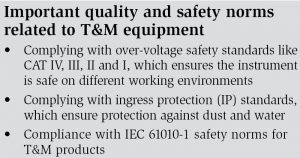 Smart testing for ‘smart devices’: For both testing managers and engineers, the challenge is to ensure quality at increasingly lower costs. To test their smart devices, organisations are transitioning from the status quo of rack-and-stack box instruments and closed turnkey ATE systems to smarter test systems that deliver connectivity and problem-solving capabilities.
Smart testing for ‘smart devices’: For both testing managers and engineers, the challenge is to ensure quality at increasingly lower costs. To test their smart devices, organisations are transitioning from the status quo of rack-and-stack box instruments and closed turnkey ATE systems to smarter test systems that deliver connectivity and problem-solving capabilities.
Customised equipment: The current focus on customised test equipment is driving the overall market, as most of the low-end T&M equipment is now available with control options.
Quality ensures long term success: According to a majority of the experts, customers are willing to spend the extra penny for good quality. However, the definition of quality can be subjective and often determined by the customer’s unique perspective. Nevertheless, experts on the panel for this report believe that objective standards of quality lead to quantifiable benchmarks, as every customer segment wants its systems to function properly and reliably on a consistent basis.
However, a few experts report that in the telecom sector, huge investments have been made in spectrum procurement but decision makers are not willing to invest in T&M equipment. Instead, mobile network operators have adopted the rental, the managed services or the capex models, which reduce the need to procure T&M equipment in this segment but can also lead to the deterioration in service or product quality.
Technology trends driving the market
Connected life styles, M2M interaction and the Internet of Things (IoT) are a few technology trends that will lead to the growth of the T&M industry.
The proliferation of smart devices has begun to influence the design and use of T&M equipment. Each ‘smart’ product has to go through a specific set of processes to ensure its usability and functionality for the intended purpose – and behind each of these steps are the design, manufacturing and testing procedures. T&M technologies are going to evolve accordingly.
It is certain that the time-to-market for new devices will continue to reduce, and the need to maintain high quality standards will drive additional complexity in these devices – and all this will be invisible to users. Test techniques and test solutions will continue to evolve to ensure that smart device developers and manufacturers can reduce time-to-market and ramp quickly to high volume manufacturing of quality products.
Connected life styles, higher use of data and the lower cost of smartphones are some trends in the telecom market. The need for high-speed connectivity will lead to network capacity increasing. Operators are using new technology like MIMO, VoLTE, LTE-Advanced and LTE Carrier Aggregation to improve spectrum efficiency and the customer experience with high data speeds. The 4G roll out and 5G-related R&D in the telecom industry will create opportunities for the T&M industry.
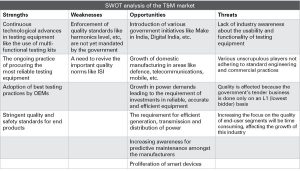 Compared to previous generations of mobile networks, 5G presents a number of new design and test challenges. While the technologies that will constitute 5G are still being worked on, the ITU-R has identified three main usage scenarios for 5G. These are: enhanced mobile broadband with up to 20Gbps peak data rate, massive machine-type communications, and ultra-reliable and low latency communications. To meet the requirements for this next generation of mobile communications, researchers are looking to a wide range of enabling technologies in RF, microwave and millimetre-wave frequencies— ranging from advanced waveforms and multiple access schemes to multiple antenna techniques such as massive MIMO and beamforming. Being the first and the best in 5G depends on tools that let you explore new signals, scenarios and topologies.
Compared to previous generations of mobile networks, 5G presents a number of new design and test challenges. While the technologies that will constitute 5G are still being worked on, the ITU-R has identified three main usage scenarios for 5G. These are: enhanced mobile broadband with up to 20Gbps peak data rate, massive machine-type communications, and ultra-reliable and low latency communications. To meet the requirements for this next generation of mobile communications, researchers are looking to a wide range of enabling technologies in RF, microwave and millimetre-wave frequencies— ranging from advanced waveforms and multiple access schemes to multiple antenna techniques such as massive MIMO and beamforming. Being the first and the best in 5G depends on tools that let you explore new signals, scenarios and topologies.
Automation is the new technology trend in the power sector and, hence, the demand for automated products is growing. Accordingly, the new technological advancements like data logging DMMs and auto power calculating power clamp meters will experience good growth. Online transmission line monitoring systems, compact Tan-delta testing machines, automatic breaker testing machines, discrete monitoring of power loss at each feeder by discoms, etc, are the areas of application.
With respect to the user experience, touch screen technologies are going to revolutionise the T&M environment. A combination of the right hardware with a ‘designed for touch’ user interface (UI) will enable us to use equipment easily and efficiently. Designed for touch UIs are crucial for creating an effective and usable touch screen environment; it is not enough to simply add a touch screen to an existing UI. The No.1 goal of T&M equipment is to be able to identify, isolate and analyse a system under test as quickly and efficiently as possible. Having an effective touch screen on the instrument can reduce the time it takes to configure the sytem and to analyse signals.
 The way forward
The way forward
Industry experts feel that it is very important to make customers aware and convinced about quality, safety and maintenance practices through the use of the right T&M instruments. They expect regulatory bodies to spread this awareness.
Moreover, T&M companies need to work as solution partners with decision makers in the electronic system design and manufacturing (ESDM) industry by offering leading-edge electronics design and test services. By adopting the latest and best T&M solutions, ESDM players can make the elusive breakthroughs that advance technology. That will lead to ideas, systems and products that will make the world a better place and the technology business more productive.



























